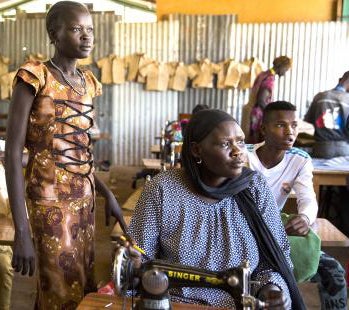Translating the Principles of the Global Compact on Refugees into Concrete Actions
Four lessons, based on evidence from evaluation, can inform future efforts to support countries hosting refugees and internally displaced persons.
Four lessons, based on evidence from evaluation, can inform future efforts to support countries hosting refugees and internally displaced persons.
By: Ann Elizabeth Flanagan
The end of a tumultuous decade fast approaches. The Syrian, Rohingya, and Venezuelan refugee crises contributed to an unprecedented increase in the number of refugees. There are almost 26 million refugees worldwide. Roughly 22 million live in developing countries and will remain refugees for many years. The international community needed to re-think its traditional response to forced displacement and develop an approach commensurate with the scale of the refugee crisis.
The Global Compact on Refugees was adopted by the United Nations General Assembly in December 2018. It calls on the international community to increase its support and shoulder some of the burden that refugees impose on host countries. The first ever Global Refugee Forum in Geneva next week is an opportunity to take stock of ongoing efforts aligned with the principles of the Compact.
In 2016, the World Bank Group implemented a new approach to addressing forced displacement. An evaluation conducted by the Bank Group’s Independent Evaluation Group (IEG), World Bank Group Support in Situations Involving Conflict-Induced Displacement, provides insights on how to build effective platforms for burden sharing and develop medium-term solutions for self-reliance and resilience. The findings of the evaluation also reinforce the importance of close coordination among host countries and their humanitarian and development partners.
Four lessons from the evaluation present what works and where attention is needed to bridge the humanitarian development divide.
Lesson 1: Sharing the burden works.
The World Bank helped establish two innovative financing mechanisms that increased international support for refugees and refugee host countries. Both instruments recognize that countries hosting large numbers of refugees are providing a global public good. The Global Concessional Financing Facility and the Window for Refugees and Host Communities leverage contributions from the donor community to allow middle-income host countries to borrow from the World Bank (among others) at lower interest rates and for expanded allocations for lower-income host countries from the International Development Association, the World Bank’s fund for the world’s poorest countries.
One condition that projects funded by these instruments need to meet is that both refugees and host communities must directly benefit from the projects. Continuous attention is needed to ensure this condition is met.
Lesson 2. Institutional changes and policy reforms are challenging to implement.
The political economy surrounding refugees is perhaps the greatest challenge to institutional changes and policy reforms that promote self-reliance and resilience. In Jordan, continuous policy dialogue has resulted in incremental changes in the sensitive area of work permits and has gradually removed barriers to employment for Syrian refugees. In Lebanon, the World Bank has had to work within policy constraints, with projects focused on short-term, labor-intensive employment for refugees in the limited sectors where refugees are legally entitled to work.
Lesson 3: Women and children refugees have specific needs and vulnerabilities.

Women and children are particularly vulnerable. Displaced women have access to fewer services and economic opportunities than men. In the Jordan and Lebanon examples, constraints to female labor force participation were not fully considered in project design. Barriers to job opportunities for women include a lack of childcare, safe transportation, or social norms that can put economic opportunities out of reach. The World Bank learned from these experiences and the lessons are informing the design of projects in other countries hosting large numbers of refugees. For instance, an employment promotion and protection scheme that is being piloted in Ethiopia requires adequate childcare arrangements, among other services, to improve the likelihood of female labor force participation.
Refugee school enrollment rates remain low, even when host countries grant access to schools (as in Jordan, Lebanon, and Turkey). Safety concerns and early marriage keep girls from attending school and child labor keeps boys from attending. Development partners can and should maintain a steady focus on addressing refugees’ unique vulnerabilities.
Lesson 4. Partnerships are essential.
The evolving approach to the forced displacement crisis has fostered strong partnerships between political leaders, humanitarian actors, and development actors at a strategic level. And, while these are helpful, strong partnerships are needed at the country-level. Only country-level partnerships can provide a coordinated and coherent refugee response. The strength of country level partnerships can vary and there is room to foster more active engagement among all stakeholders. Political commitment and progressive governments foster coordination, often using coordination mechanisms like the Comprehensive Refugee Response Framework or the Jordan Compact. These mechanisms align governments, donor countries, and humanitarian and development actors in a coherent approach that draws on the comparative advantages of each, and increases the potential benefits for refugees, their host communities and countries, and the global community.
Pictured above: Mother and child in the Zaatari Refugee camp, Jordan. Photo credit: Mohamed Azakir / World Bank

Add new comment